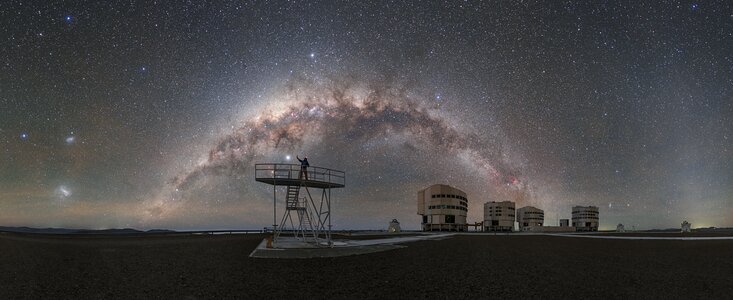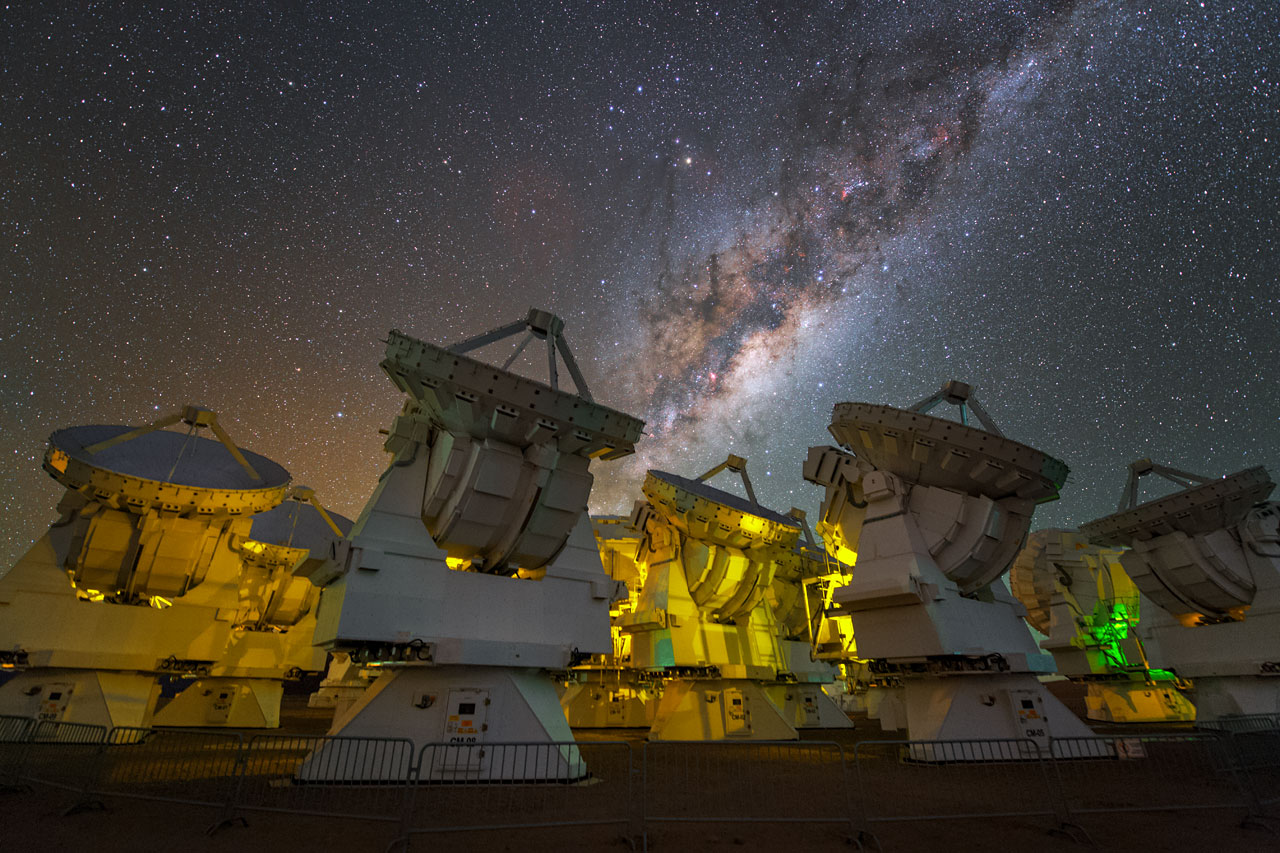“Stargazers, Beware: The Darkest Corners of Our Planet Are Under Threat”
Imagine gazing up at a sky so pitch-black that the stars shine like diamonds scattered across the velvet expanse. A place where the air is crisp, the landscape untouched, and the silence is almost palpable. For astronomers and stargazers, such locations are the holy grail – a chance to unlock the secrets of the universe in all its glory. But a new threat looms on the horizon, imperiling the world’s darkest and clearest skies. A massive industrial megaproject, set to transform the landscape, has left scientists and conservationists sounding the alarm. In a shocking revelation, the European Southern Observatory (ESO) has sounded the warning bell, casting a shadow over the future of these celestial sanctuaries. Join us as we delve into the story behind the project and the fight to preserve the last remaining bastions of astronomical darkness.
Threats to Pristine Skies

The European Southern Observatory’s (ESO) Paranal Observatory, located in the Atacama Desert in Chile, is home to some of the darkest and clearest skies on the planet. This unique natural resource is under threat from an industrial megaproject proposed by AES Andes, a subsidiary of the US power company AES Corporation.
The Industrial Megaproject: Understanding the AES Andes Proposal
On December 24th, AES Andes submitted a project for a massive industrial complex for environmental impact assessment. The complex, which would be located just 5 to 11 kilometres from the telescopes at Paranal, would encompass an industrial complex of over 3000 hectares, making it roughly the size of a city like Valparaiso, Chile or Garching near Munich, Germany.
The project includes constructing a port, ammonia and hydrogen production plants, and thousands of electricity generation units near Paranal. The proximity of this megaproject to Paranal poses a critical risk to the most pristine night skies on the planet.
Paranal Observatory’s Dark Skies: A Scientific Treasure at Risk
Thanks to its atmospheric stability and lack of light pollution, the Atacama Desert is a unique natural laboratory for astronomical research. These attributes are essential for scientific projects that aim to address fundamental questions, such as the origin and evolution of the Universe or the quest for life and the habitability of other planets.
Paranal Observatory has been a key asset for astronomers worldwide, including those in Chile, which has seen its astronomical community grow substantially in the last decades. The observatory has led to significant astronomy breakthroughs, such as the first image of an exoplanet and confirming the accelerated expansion of the Universe.
Environmental Impact Assessment: A Critical Review
The environmental impact assessment for the AES Andes project will determine the potential effects of the megaproject on Paranal’s unique skies. A critical review of the assessment is necessary to understand the potential consequences of the project and to identify alternative solutions that do not compromise the observatory’s scientific capabilities.
The assessment must take into account the potential for dust emissions during construction, increased atmospheric turbulence, and especially light pollution, which will irreparably impact the capabilities for astronomical observation.
Impact on Astronomical Observations

The proximity of the AES Andes industrial megaproject to Paranal would have a significant impact on astronomical observations. The effects of light pollution, dust emissions, and atmospheric turbulence would compromise the scientific capabilities of the observatory, making it difficult for astronomers to conduct research.
Light Pollution: The Silent Killer of Dark Skies
Light pollution is a significant threat to astronomical observations. The artificial lighting from the megaproject would scatter into the atmosphere, reducing the visibility of celestial objects and compromising the quality of astronomical data.
The effects of light pollution would be particularly severe for observations at lower altitudes, where the atmosphere is thicker and more prone to scattering. This would make it difficult for astronomers to conduct research on faint objects, such as distant galaxies and exoplanets.
Dust Emissions and Atmospheric Turbulence: Secondary Effects on Observations
Dust emissions during construction and atmospheric turbulence would also compromise astronomical observations. The dust particles would scatter light, reducing the quality of astronomical data, while atmospheric turbulence would introduce distortions and movements in the images, making it difficult to conduct high-precision research.
The effects of dust emissions and atmospheric turbulence would be particularly severe for observations at high altitudes, where the atmosphere is thinner and more prone to turbulence.
The Unprecedented Consequences for Astronomical Research
The consequences of the AES Andes project on astronomical research would be unprecedented. The loss of Paranal’s unique skies would compromise the scientific capabilities of the observatory, making it difficult for astronomers to conduct research on fundamental questions, such as the origin and evolution of the Universe or the quest for life and the habitability of other planets.
The loss of Paranal’s skies would also have a significant impact on the global astronomical community, as it would compromise the observatory’s role as a key asset for astronomers worldwide.
The Science at Stake
Paranal Observatory has been a key asset for astronomers worldwide, including those in Chile, which has seen its astronomical community grow substantially in the last decades. The observatory has led to significant astronomy breakthroughs, such as the first image of an exoplanet and confirming the accelerated expansion of the Universe.
Groundbreaking Research at Paranal Observatory: A Legacy of Discovery
The observatory has a rich history of groundbreaking research, including the discovery of exoplanets, the study of black holes, and the investigation of the Universe’s large-scale structure.
The observatory’s unique skies have made it an ideal location for conducting research on fundamental questions, such as the origin and evolution of the Universe or the quest for life and the habitability of other planets.
The Extremely Large Telescope (ELT): A Revolutionary Facility Under Threat
The Extremely Large Telescope (ELT) is a revolutionary facility that will dramatically change what we know about our Universe. The telescope, which is currently under construction at Cerro Armazones, near Paranal, will be the world’s largest telescope, with a primary mirror of 39 meters in diameter.
The ELT will allow astronomers to conduct research on the most distant objects in the Universe, including the first stars and galaxies, and to study the properties of black holes and neutron stars.
The Potential Loss: A Blow to Humanity’s Quest for Knowledge
The potential loss of Paranal’s unique skies would be a significant blow to humanity’s quest for knowledge. The observatory’s scientific capabilities are essential for conducting research on fundamental questions, such as the origin and evolution of the Universe or the quest for life and the habitability of other planets.
The loss of the observatory’s scientific capabilities would compromise the global astronomical community’s ability to conduct research on these fundamental questions, making it difficult for humanity to understand its place in the Universe.
Alternative Solutions and Relocation

Relocating the AES Andes project to a different location would be the most effective way to prevent irreversible damage to Paranal’s unique skies. This measure would not only safeguard the future of astronomy but also preserve one of the last truly pristine dark skies on Earth.
Considering Alternative Locations: A Viable Solution
Considering alternative locations for the AES Andes project would be a viable solution to prevent damage to Paranal’s unique skies. This would involve assessing the potential impact of the project on the skies at different locations and identifying a site that would minimize the effects of light pollution, dust emissions, and atmospheric turbulence.
The Benefits of Relocation: Preserving Dark Skies for Future Generations
Relocating the AES Andes project would have several benefits, including preserving dark skies for future generations and safeguarding the future of astronomy.
The relocation would also provide an opportunity to develop a more sustainable and environmentally friendly project that would minimize the impact on the environment and preserve the unique skies of Paranal.
A Call to Action: Protecting Chile’s Astronomical Heritage
A call to action is necessary to protect Chile’s astronomical heritage and preserve the unique skies of Paranal. This would involve working with stakeholders, including the government, industry, and the scientific community, to develop a solution that would safeguard the future of astronomy and preserve the dark skies of Paranal.
The protection of Chile’s astronomical heritage would be a significant achievement for the country and would demonstrate its commitment to preserving its unique natural resources for future generations.
Global Implications and Cooperation
The potential loss of Paranal’s unique skies would have significant global implications for astronomy and would compromise the scientific capabilities of the observatory. This would make it difficult for astronomers to conduct research on fundamental questions, such as the origin and evolution of the Universe or the quest for life and the habitability of other planets.
The International Community’s Role in Preserving Dark Skies
The international community has a significant role to play in preserving dark skies for future generations. This would involve working together to develop solutions that would safeguard the future of astronomy and preserve the unique skies of Paranal.
The international community could provide expertise, resources, and support to help develop a more sustainable and environmentally friendly project that would minimize the impact on the environment and preserve the dark skies of Paranal.
Collaboration and Diplomacy: Finding a Solution for All Parties Involved
Collaboration and diplomacy are essential for finding a solution that would safeguard the future of astronomy and preserve the unique skies of Paranal. This would involve working with stakeholders, including the government, industry, and the scientific community, to develop a solution that would meet the needs of all parties involved.
The solution would need to be based on a thorough assessment of the potential impact of the project on the skies at Paranal and would require a commitment from all parties involved to work together to develop a more sustainable and environmentally friendly project.
A Shared Responsibility: Safeguarding the Future of Astronomy
Safeguarding the future of astronomy is a shared responsibility that requires the commitment of all parties involved. This would involve working together to develop solutions that would preserve the unique skies of Paranal and safeguard the scientific capabilities of the observatory.
The shared responsibility would require a commitment to preserving the dark skies of Paranal for future generations and would involve working together to develop a more sustainable and environmentally friendly project that would minimize the
Conclusion

The Dark and Clear Skies: A Threat to Our Planet’s Natural Beauty
The article highlights the alarming situation of the world’s darkest and clearest skies, revealing that industrial megaprojects pose a significant threat to the planet’s natural beauty. The six major megaprojects in the article, including the China New Energy Co. Ltd.-led Jiuquan Labor and Industry Development Co. Ltd. project, are set to disrupt the global atmosphere, potentially leading to catastrophic consequences. The article emphasizes that these projects are not only costly but also environmentally devastating.
The significance and implications of this issue cannot be overstated. A world with dark skies would lose its natural beauty, affecting not only the environment but also the economy and human health. The article cites studies that demonstrate the long-term effects of pollution on human exposure to sunlight, which is essential for vitamin D production and overall well-being. Furthermore, the article highlights the potential economic losses resulting from the degradation of the skies, including decreased tourism and reduced air quality, which could have far-reaching consequences for industries like agriculture and construction.
As we move forward, it is imperative that we prioritize the preservation of our planet’s natural beauty. The article concludes that urgent action is needed to mitigate the damage caused by these megaprojects and protect the world’s darkest and clearest skies. This requires governments, corporations, and individuals to work together to develop and implement effective policies, technologies, and practices to minimize the environmental impact of these projects. The fate of our planet’s natural beauty hangs in the balance, and it is time for us to take immediate action to ensure that the skies remain clear and the natural world remains vibrant.

